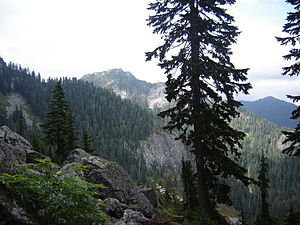Mount Seymour Provincial Park
|
Mount Seymour Provincial Park
|
||
|
Mount Seymour Provincial Park |
||
| location | British Columbia (Canada) | |
| surface | 35.08 km² | |
| WDPA ID | 65322 | |
| Geographical location | 49 ° 13 ' N , 122 ° 34' W | |
|
|
||
| Setup date | Jan. 31, 1936 | |
| administration | BC parks | |
The Mount Seymour Provincial Park is a 3,508-hectare Provincial Park in the Canadian province of British Columbia . The park is located 15 kilometers north of Vancouver in the North Shore Mountains and is a recreational area for the people of Vancouver. The park partially borders the Indian Arm Provincial Park to the east .
investment
The park is accessible from North Vancouver . Its highest peaks are Mount Bishop with 1509 m , the eponymous Mount Seymour with 1453 m and Mount Elsay with 1418 m . There are several lakes in the park. The largest lake is Elsay Lake in the north of the park. Smaller lakes include Pencier, Flower, Gopher and Goldie Lake, from which streams flow into the eastern Indian arm of Burrard Inlet .
The park is a category II protected area ( national park ).
history
Mount Seymour was named after Frederick Seymour , who was Governor of British Columbia from 1864 to 1869. The first known ascent of Mount Seymour was in 1908 by a group from the BC Mountaineering Club . In 1929 members of the Alpine Club of Canada explored the suitability of the site as a ski area. The following year the club leased the area for 21 years, but the Great Depression prevented it from being able to use the area as a ski resort. Therefore, in 1935, the club applied to the provincial government to protect the area as a park. The provincial park was established in 1936 .
Flora and fauna
The park is reforested with coniferous forest up to a height of 1000 meters, interspersed with old Douglas firs and Nootka false cypresses . From 1000 meters, purple firs and mountain hemlocks grow . Numerous alpine flowers bloom on the mountain meadows in summer.
Numerous small and large mammal species live in the park. Deer and coyotes are common . Black bears , bobcats and pumas also live in the hinterland . There are also numerous other species such as rabbits, squirrels and pine marten . Many species of bird are native to the park area, including the blue jay , the heraldic bird of British Columbia, titjay , golden cockerel and grouse . Several species of falcons can be seen on their annual migrations.
activities
The park offers views of the city of Vancouver and the Indian Arm. There are five picnic areas in the park, and there is a cafeteria and sanitary facilities at the parking lot. 14 signposted paths of different lengths and degrees of difficulty run through the park, most of which are used by both cyclists and hikers. Only the higher trails are reserved for hikers. Five kilometers of the Baden Powell Trail, a 42-kilometer hiking trail in northern Vancouver, runs through the park. In winter the park is a ski area, from mid-December to the end of March snowshoe trails and cross-country trails are laid out. A private provider operates four ski lifts. The park administration offers nature experience programs for groups, including a bear program.
literature
- Helga Walter: Pacific route: Canada's dreamy coastal route . Kaarst: Conbook Verlag 2008, ISBN 978-3-934918-33-7
Web links
- Mount Seymour Provincial Park . In: BC Geographical Names (English)
- Mount Seymour Provincial Park . In: English language website of the park at BC Parks


